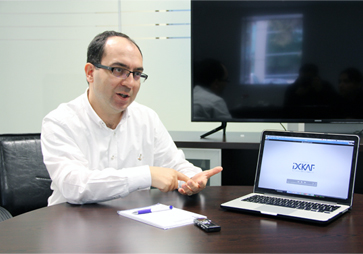
Prof. Haluk Külah
Having graduated from the Electrical and Electronics Engineering Department in 1996, Prof. Haluk Külah, received his Master's degree from the same department under the supervision of Tayfun Akın and left for University of Michigan in 1998. After working for six years in this university in MEMS field, he was back in METU. Since 2004, he has been developing research projects in the field of biomedicine rather than defense industry and focused on mainly two subjects, one is developing on-chip laboratory systems (for example, taking a human blood sample and sorting out cancer cells through systems that would count and measure them and making it possible to get early recognition in cancer), and the other is the systems producing energy through action on the chip (energy generators).
Why eight channels? The current cochlear implant technology chooses eight fundamental frequencies on the 10 kHz band, expanding them as far as it can including its neighborhoods and thus enabling hearing. So, what the current technology tells is; if we make eight channels, we can cover the sound bandwidth that a standard cochlear implant covers today. This technology has the following advantages: Today, 8 channels can fit in here, but chip technology is moving forward, which means that you can put millions of transistors today, while you used to be able to put 100-200 ones in one chip before. Likewise, while there are eight cantilevers that you can place in the same area today, maybe 10 years from now, that number could rise to 20 or even 30. So, this is an open-ended technology; perhaps in 20 years, we could fit 20-30 channels (cantilevers) and help better hearing. However, eight channels are enough as far as doctors tell us right now.
In the hearing process of a healthy person; an acoustic signal received from an outside source vibrates the eardrum and bones and then the vibration is transmitted to the cochlea. The hairs in the cochlea vibrate and these hairs electrochemically stimulate the nerve. The loss or inherent lack of small hairs that are found in the cochlea in the ear and enable hearing by stimulating the nerves when vibrating with sound is one of the most common types of hearing loss that appears in many different forms. The current solution to this problem is a standard cochlear implant. In this system, there is a receiver on the outside, there is also a part of it inside, which transmits the signal as RF (radio frequency) from the outside and enters into the cochlea via an electrode and makes electrical stimulation instead of hairs, but the system’s battery needs to change every day. As there is an external part, this may cause challenges in daily use; especially young people do not prefer using this system. The purpose of the ERC project is to make sure that all these procedures are performed in the ear.
Prof. Külah stated that his project completely changed the working principle of the present cochlear implant systems, and they were awarded the ERC project as they demonstrated in their scientific paper that this was very challenging but still applicable, and if they succeeded, everything in Cochlear implant technology would change and a new era would start. Prof. Haluk Külah mentioned that upon the rejection of his first application to ERC, they established a spin off company at METU Technopark on their research topic and carried on the cancer research, and in their third applications, they changed the research topic from cancer diagnosing systems based on blood into in-ear hearing systems, and they included the cochlear implant into the project; so they were invited to an interview in Brussels; however, they could not be one of the projects to be subsidized although they got a good score. In their final application, they were granted the ERC support as the first winner project of the panel. Highlighting that this is frequently experienced in the European Union project submissions but it requires carrying on working diligently, Prof. Külah added that ERC is a far-reaching and competitive organization that supports applicable projects to change the technology radically. Prof. Külah said they work as a team in drafting a project and Dr. Özge Zorlu and Dr. Ebru Özgür have valuable contributions both in maturation of ideas and writing stages. Noting that ERC is a highly competitive project support, Prof. Külah continued:

